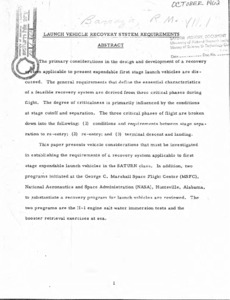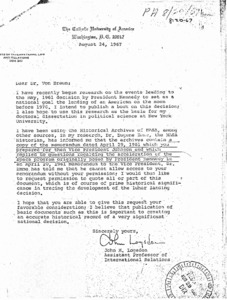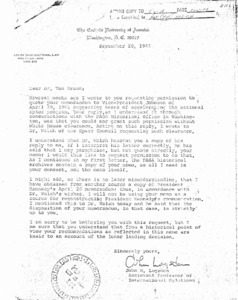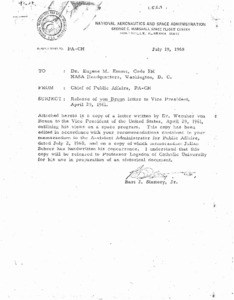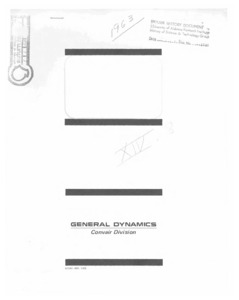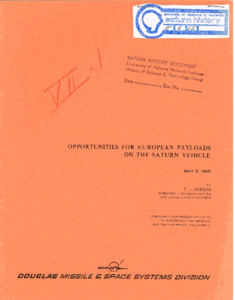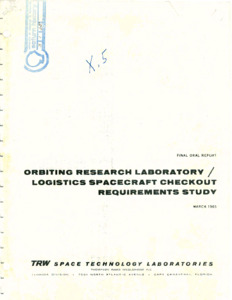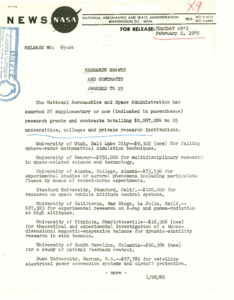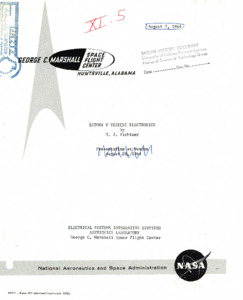
Browse Items (29 total)
Sort by:
-
"Launch Vehicle Recovery System Requirements."
The primary considerations in the design and development of a recovery system applicable to present expendable first stage launch vehicles are discussed. The general requirements that define the essential characteristics of a feasible recovery system are derived from three critical phases during flight. The degree of criticalness is primarily influenced by the conditions at stage cutoff and separation. The three critical phses of flight are broken down into the following: (1) conditions and requirements between stage separation to re-entry; (2) re-entry; and (3) terminal descent and landing. -
"Letter to Dr. Wernher von Braun."
Letter to Wernher von Braun from John M. Logsdon asking that Braun approves a request to quote his memorandum in his book. -
"Letter to Dr. Wernher von Braun."
Letter to Wernher von Braun from John M. Logsdon reiterating his request to use Braun's memorandum in his book as well as apologizing for any miscommunication. -
"Memorandum to Dr. Eugene M. Emme, Code EH, NASA Headquarters, Washington, D. C. from Bart J. Slattery, Jr., Chief of Public Affairs."
Memorandum from NASA Chief of Public Affairs to Eugine M. Emme. States that a video from Wernher von Braun are included regarding his views on the NASA program. -
"NEXUS concept of a large reusable earth launch vehicle."
Aspects of Earth-to-orbit delivery are discussed and a cost analysis of the logistic operation and the cost of orbital operations are presented. Probabilities of success of orbital delivery and the operational and economic aspects of establishing large orbital installations and maintaining a large transportation volume in the 1975/85 time period are compared for the two cases using a large number of Saturn V versus a smaller number of 1-stage chemical Post-Saturn launch vehicles. Performance parameters of chemical, chemonuclear and nuclear launch vehicles are compared. The concept of a blunt launch vehicle configuration referred to as NEXUS is presented in detail. Applications of this configuration to chemonuclear propulsion and to a 50 ft diameter version of Saturn V with recoverable first stage are discussed. -
"Opportunities for European Payloads on the Saturn Vehicle."
Prepared for presentation to the Eurospace Conference. In this paper, we will not deal with the first two questions, which must be of interest to every potential experimenter, but only with the last question of vehicle availability. -
"Orbiting research laboratory/logistics spacecraft checkout requirements study."
This report presents the results of the study of Orbiting Research Laboratory and Logistic Spacecraft Checkout Requirements as they relate to prelaunch operations at MILA. The study was performed jointly by the Florida Division and the Systems Research and Analysis Division of TRW Space Technology Laboratories for NASA under the terms of contract NAS10-1076. -
"Report to the Congress from the President of the United States"
A report to Congress from White House regarding the accomplishments of NASA. -
"Research grants and contracts awarded to 25 : NASA news."
Press-release detailing 27 research grants sent to numerous universities. -
"Saturn V vehicle electronics."
This presentation is a review of the electrical and electronics systems of the Saturn V launch vehicle. Since airborne and ground electronics cannot be separated as a system, this presentation will touch upon both the airborne and ground checkout equipment. Certain airborne electronic items are singled out in order to elaborate upon the application of computers for checkout and launch. This review covered in a broad sense such airborne electronics as the control computer, the measuring telemetry and RF systems, the switch selector, the digital command receiver and the remote automatic calibration system. The ground support equipment electronics covered include such equipment as the data link, computer system and display systems. The importance of software in the Saturn V program is stressed by the application of a standard program language through the use of acceptance test or launch language (ATOLL).
